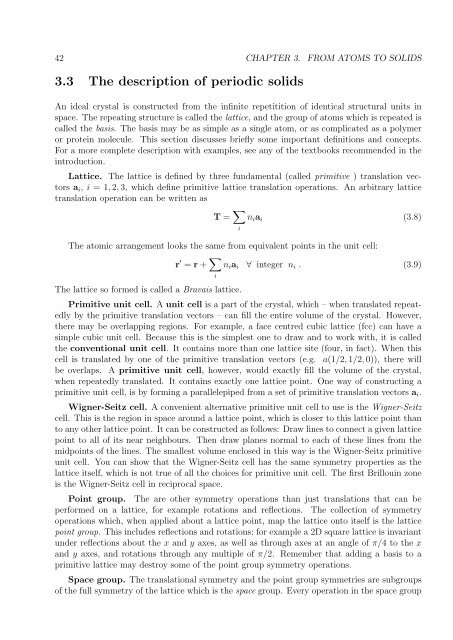Set of supplementary notes.
Set of supplementary notes.
Set of supplementary notes.
Create successful ePaper yourself
Turn your PDF publications into a flip-book with our unique Google optimized e-Paper software.
42 CHAPTER 3. FROM ATOMS TO SOLIDS<br />
3.3 The description <strong>of</strong> periodic solids<br />
An ideal crystal is constructed from the infinite repetitition <strong>of</strong> identical structural units in<br />
space. The repeating structure is called the lattice, and the group <strong>of</strong> atoms which is repeated is<br />
called the basis. The basis may be as simple as a single atom, or as complicated as a polymer<br />
or protein molecule. This section discusses briefly some important definitions and concepts.<br />
For a more complete description with examples, see any <strong>of</strong> the textbooks recommended in the<br />
introduction.<br />
Lattice. The lattice is defined by three fundamental (called primitive ) translation vectors<br />
a i , i = 1, 2, 3, which define primitive lattice translation operations. An arbitrary lattice<br />
translation operation can be written as<br />
T = ∑ i<br />
n i a i (3.8)<br />
The atomic arrangement looks the same from equivalent points in the unit cell:<br />
r ′ = r + ∑ i<br />
n i a i ∀ integer n i . (3.9)<br />
The lattice so formed is called a Bravais lattice.<br />
Primitive unit cell. A unit cell is a part <strong>of</strong> the crystal, which – when translated repeatedly<br />
by the primitive translation vectors – can fill the entire volume <strong>of</strong> the crystal. However,<br />
there may be overlapping regions. For example, a face centred cubic lattice (fcc) can have a<br />
simple cubic unit cell. Because this is the simplest one to draw and to work with, it is called<br />
the conventional unit cell. It contains more than one lattice site (four, in fact). When this<br />
cell is translated by one <strong>of</strong> the primitive translation vectors (e.g. a(1/2, 1/2, 0)), there will<br />
be overlaps. A primitive unit cell, however, would exactly fill the volume <strong>of</strong> the crystal,<br />
when repeatedly translated. It contains exactly one lattice point. One way <strong>of</strong> constructing a<br />
primitive unit cell, is by forming a parallelepiped from a set <strong>of</strong> primitive translation vectors a i .<br />
Wigner-Seitz cell. A convenient alternative primitive unit cell to use is the Wigner-Seitz<br />
cell. This is the region in space around a lattice point, which is closer to this lattice point than<br />
to any other lattice point. It can be constructed as follows: Draw lines to connect a given lattice<br />
point to all <strong>of</strong> its near neighbours. Then draw planes normal to each <strong>of</strong> these lines from the<br />
midpoints <strong>of</strong> the lines. The smallest volume enclosed in this way is the Wigner-Seitz primitive<br />
unit cell. You can show that the Wigner-Seitz cell has the same symmetry properties as the<br />
lattice itself, which is not true <strong>of</strong> all the choices for primitive unit cell. The first Brillouin zone<br />
is the Wigner-Seitz cell in reciprocal space.<br />
Point group. The are other symmetry operations than just translations that can be<br />
performed on a lattice, for example rotations and reflections. The collection <strong>of</strong> symmetry<br />
operations which, when applied about a lattice point, map the lattice onto itself is the lattice<br />
point group. This includes reflections and rotations; for example a 2D square lattice is invariant<br />
under reflections about the x and y axes, as well as through axes at an angle <strong>of</strong> π/4 to the x<br />
and y axes, and rotations through any multiple <strong>of</strong> π/2. Remember that adding a basis to a<br />
primitive lattice may destroy some <strong>of</strong> the point group symmetry operations.<br />
Space group. The translational symmetry and the point group symmetries are subgroups<br />
<strong>of</strong> the full symmetry <strong>of</strong> the lattice which is the space group. Every operation in the space group








